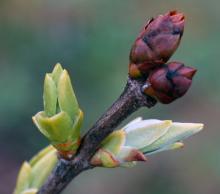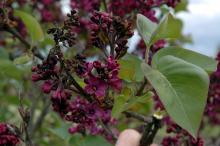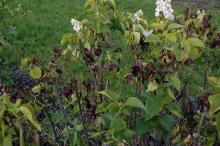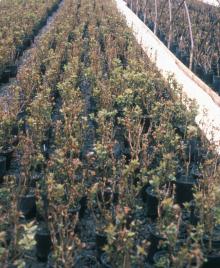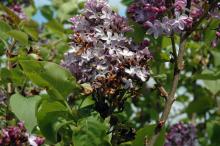Cause Pseudomonas syringae pv. syringae, the bacterium that also causes bacterial blight of pear, blueberry, cherry, maple, and many other woody plants. Losses can be substantial due to this disease in nursery production. Older landscape plantings can still thrive despite high disease pressure. Bacteria overwinter on diseased twigs or as epiphytes on healthy wood. Factors that weaken or injure plants predispose them to disease. Such factors include wounds, both accidental and from pruning or budding, frost damage, incorrect soil pH, poor or improper nutrition, and infection by other pathogens.
Bacterial sources can include old cankers, healthy buds, low populations within plants (with or without cankers), leaf surfaces, nearby weeds and grasses, even soil. Bacteria spread by wind, rain, insects, tools, and infected nursery stock. Mild, moist weather favors disease development.
Although the bacteria survive on the outside of the plant they must get inside and multiply in the space between plant cells (apoplast) to cause disease. These pathogenic bacteria inject several proteins and small-molecule toxins to get past host immune mechanisms. Once inside, the bacteria induce a watery, nutrient rich environment between the plant cells where they can multiply and continue colonization of the plant tissues. Bacteria also produce a protein that acts as an ice nucleus, increasing frost wounds that bacteria easily colonize and expand.
Some species of Syringa have shown resistance in western Washington including S. josikaea, S. Komarowii, S. microphylla, S. pekinensis, and S. reflexa. Most cultivars of S. vulgaris are susceptible, but some have been observed with less disease when planted in a garden; those cultivars include Edith Cavell, Glory, Ludwig Spaeth, and Pink Elizabeth. Note that 'Ludwig Spaeth' is highly susceptible under intense nursery production systems.
Symptoms The disease starts as brown spots on stems and leaves of young shoots as they develop in early spring. A yellow halo may also be around the spot. Spots become black and grow rapidly, especially during rainy periods. Further infectious development depends on the age of the part attacked.
On young stems, infection spreads around the stem and girdles it so the shoot bends over at the lesion and the parts above it wither and die. On mature stems, spots usually enlarge along the stem, causing leaf death only within the infected area.
Young, infected leaves blacken rapidly starting near the margin and continuing in a wedge-shaped pattern down to the petiole. Eventually the entire leaf dies. On older leaves, spots enlarge slowly. Sometimes, several spots will run together, and the leaf may crinkle at the edge or along the midvein. Flower clusters also may be infected and rapidly become blighted and blackened.
Buds may fail to open or may turn black and die shortly after opening. Symptoms are similar to those of winter injury.
Cultural control
- Maintain adequate spacing between plants and prune to provide good air circulation within the canopy.
- Prune out and burn all affected tissues immediately.
- Plant resistant species or cultivars.
- Do not fertilize late in the growing season. Do not over-fertilize young plants.
- In spring, protect from rain and frost with plastic hoop houses or similar structures. This treatment has been as good as the best chemical method.
Chemical control Focus first on cultural control tactics. Spray before fall rains and again before budbreak in spring. Bacteria resistant to both copper products and antibiotics have been detected in many nurseries. Limit the use of any one group during crop production. Some copper products may be phytotoxic when used during the early growing season. Use of anti-transpirants has not been effective.
- Agri-Mycin 50 at 5.3 to 16 oz/100 to 300 gal water/A. Tolerant strains of bacteria easily develop with repeated use of this product. Alternate with other bactericides to prevent or delay buildup of tolerant strains. Group 25 fungicide. 12-hr reentry.
- Arbor-OTC is registered for trunk injection, see label for details. Group 41 fungicide (antibiotic). 12-hr reentry.
- Badge X2 at 1.5 to 5 lb/A. Use lower rates when active new growth is present. Group M1 fungicide. 48-hr reentry. O
- Bordeaux (copper sulfate plus hydrated lime) at 4-4-100. An effective combination of products even when bacteria are resistant to copper. Group M1 fungicide. O
- CuPRO 5000 at 1.5 to 5 lb/A but only up to 2 lb/A when new growth is present. Group M1 fungicide. 48-hr reentry.
- Cuprofix Ultra 40 Disperss at 0.75 lb/100 gal water. Group M1 fungicide. 48-hr reentry.
- FireWall 50 WP at 1.36 oz/25 gal water. Group 25 fungicide. 12-hr reentry.
- Grotto at 0.5 to 2 gal/30 to 100 gal water/A. Group M1 fungicide. 4-hr reentry.
- Junction at 1.5 to 3 lb/A. Can be more effective than other copper-based products when copper-resistant bacteria are present. Spray solution pH should be above 6.5. Group M1 + M3 fungicide. 48-hr reentry.
- KleenGrow at 6 to 38 fl oz/100 gal water. 48-hr reentry.
- Monterey Liqui-Cop at 3 Tbsp/gal water. H
- Nu-Cop 50 DF at 1 lb/100 gal water. Group M1 fungicide. 48-hr reentry.
- Phyton 27 at 1.3 to 2.5 oz/10 gal water. Group M1 fungicide. 48-hr reentry.
Biological control Use in conjunction with other control tactics such as thorough sanitation. May not be compatible with copper-based products.
- Stargus (Bacillus amyloliquefaciens strain F727) at 2 to 4 quarts/100 gal water plus a nonionic surfactant. Group BM02 fungicide. 4-hr reentry. O
- Triathlon BA (Bacillus amyloliquefaciens strain D747) at 0.5 to 6 quarts/100 gal water. Group BM02 fungicide. 4-hr reentry. O
References Gould, C.J. and W.E. Vassey. 1977. Lilacs resistant to bacterial blight. Proceedings of the International Lilac Society 6:48-57.
Scheck, H.J., Pscheidt, J.W., and Moore, L.W. 1996. Copper and streptomycin resistance in strains of Pseudomonas syringae from Pacific Northwest nurseries. Plant Disease 80:1034-1039.



